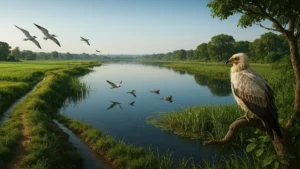In a heartening development, the annual waterhole census conducted in the National Desert Park, Jaisalmer, Rajasthan, has revealed a significant presence of the critically endangered Great Indian Bustard. The survey, which employs the waterhole technique during the scorching summer months, counted a staggering 64 Great Indian Bustards within the park’s boundaries. This marks a notable increase from the previous year’s census in 2022, which recorded 42 birds using the same waterhole technique.
The Elusive Great Indian Bustard
Also known as the “Godawan,” the Great Indian Bustard is the state bird of Rajasthan and a critically endangered species that primarily inhabits dry grasslands. These majestic birds are easily recognizable with their distinctive black crown contrasting against their pale neck and head, accompanied by a brownish body and wings marked with black, brown, and grey hues.
Waterhole Census: A Strategic Approach
Wildlife conservationists often employ the waterhole technique during the sweltering summer months to accurately count the wildlife population in a given area. In preparation for the 2024 census, forest officials strategically constructed 42 waterholes within the National Desert Park. A dedicated team of 84 officers was deployed on watchtowers near these waterholes throughout the census period.
The census was meticulously timed to coincide with the auspicious Vaishakh Purnima (full moon night) on 23rd May, as experts believe that the full moon facilitates easier spotting of animals without the need for artificial lighting. Moreover, the intense heat, with temperatures regularly exceeding 45 degrees Celsius in the region, compels wildlife to seek hydration at least once every 24 hours, maximizing the chances of accurate counting.
Bustard Hotspots and Biodiversity
According to the forest officials, the census revealed that 21 Great Indian Bustards were spotted in the Ramdevra region, while a whopping 43 were observed in the Sipla, Sudasari, Gazai Mata, Jamra, Chouhani, and Barna areas of Jaisalmer. In addition to the bustards, the census also recorded over 1,000 Chinkaras, 30 Desert Cats, 150 Foxes, and more than 100 Vultures, highlighting the rich biodiversity of the National Desert Park.
Legal Protection and Conservation Efforts
Recognizing the critical status of the Great Indian Bustard, the Indian government has taken proactive measures to ensure its protection. The species is listed under Schedule 1 of the Indian Wildlife (Protection) Act 1972, granting it the highest level of legal protection. It is also included in Schedule I of the Convention on Migratory Species (CMS) and Appendix I of the Convention on International Trade in Endangered Species of Wild Fauna and Flora (CITES).
To further bolster conservation efforts, the Union Ministry of Environment, Forest and Climate Change, Rajasthan Forest Department (RFD), and Wildlife Institute of India established a breeding center at Sam in Jaisalmer in 2019, with an additional center at Ramdevra operationalized in 2022. The ministry has also identified the Great Indian Bustard as a species for the recovery program under the Integrated Development of Wildlife Habitats.
A Glimmer of Hope
According to the Union Ministry of Wildlife Institute of India, as of August 2023, there were approximately 150 Great Indian Bustards in India, with a staggering 128 residing in Rajasthan alone. The remaining birds are scattered across the states of Gujarat, Maharashtra, Andhra Pradesh, and Karnataka, with each state accounting for less than 10 individuals.
The encouraging results of the waterhole census in Jaisalmer’s National Desert Park offer a glimmer of hope for the conservation of this magnificent species. With continued efforts and collaborative initiatives, the Great Indian Bustard may yet find a secure future in its natural habitats.




 Chhattisgarh Gets Its First Ramsar Site:...
Chhattisgarh Gets Its First Ramsar Site:...
 Maharashtra Ends the Century-Old Pagdi S...
Maharashtra Ends the Century-Old Pagdi S...
 Maharashtra Govt Partners with Microsoft...
Maharashtra Govt Partners with Microsoft...







